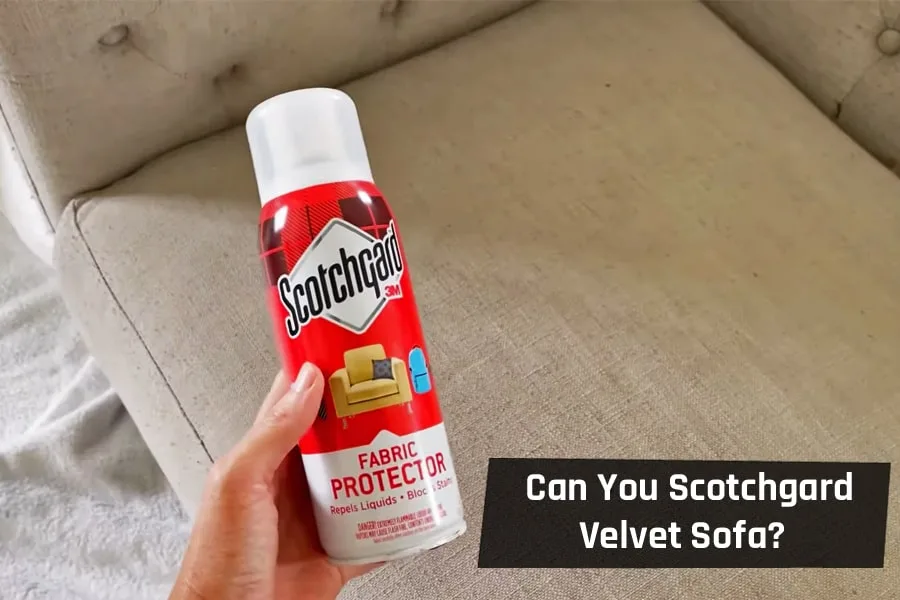Scotchgard, a popular brand of fabric protector, is commonly used to guard against stains and spills on various types of upholstery. While it is generally suitable for most fabrics, including cotton, polyester, and some blends, it may not be recommended for velvet sofas.
Velvet is a delicate fabric characterized by its plush and luxurious texture, and applying Scotchgard can potentially alter its appearance or cause discoloration. It is best to consult the manufacturer’s guidelines or seek professional advice specifically for velvet upholstery protection.
Protecting your velvet sofa should prioritize gentle cleaning methods and prompt treatment of spills rather than using Scotchgard.

What Is Scotchgard?
Scotchgard is a brand of fabric protector developed by 3M, a multinational corporation renowned for its innovative products.
It is designed to create a protective barrier on various types of fabrics, shielding them against stains, spills, and dirt.
Scotchgard works by forming an invisible shield around individual fabric fibers, causing liquids to bead up on the surface instead of penetrating and staining the fabric.
Scotchgard is commonly used on upholstery, carpets, clothing, and other fabric items that are prone to staining.
By repelling liquids such as water, oil, and wine, Scotchgard makes it easier to clean and maintain the fabric, prolonging its life and preserving its original appearance.
In addition to stain resistance, Scotchgard can also provide some protection against fading caused by exposure to sunlight.
The application of Scotchgard involves spraying the product evenly on a clean and dry fabric surface, following the instructions provided by the manufacturer.
It is important to allow proper drying time before using or exposing the fabric to moisture.While Scotchgard offers an added layer of protection, it is important to note that it is not foolproof.
Promptly addressing spills and using appropriate cleaning methods for different fabric types remain essential practices for maintaining fabric integrity.

Can You Scotchgard Velvet?
Scotchgard is generally not recommended for use on velvet fabric. Velvet is a delicate and luxurious fabric with a unique texture, typically composed of densely woven fibers that create a soft and plush surface.
Applying Scotchgard to velvet can potentially alter its appearance, texture, and even cause discoloration.
Velvet has a characteristic sheen and nap that can be easily affected by certain chemicals or treatments. Scotchgard contains various chemicals that are designed to create a protective barrier on fabrics, but they may not interact well with the delicate fibers of velvet.
The application of Scotchgard could potentially flatten the velvet pile, change its texture, or cause the fibers to clump together, resulting in an undesirable appearance.
To protect velvet upholstery, it is best to consult the manufacturer’s guidelines or seek professional advice on the appropriate cleaning and maintenance methods.
In general, gentle cleaning techniques should be employed, and spills should be promptly blotted or gently dabbed to prevent them from setting into the fabric.
It is important to prioritize the preservation of the velvet’s unique texture and appearance by avoiding treatments that could potentially damage or alter it.
Does Scotchgard Work On Velvet?
Scotchgard is not typically recommended for use on velvet fabric. While Scotchgard is known for its ability to protect various types of fabrics from stains and spills, velvet is a delicate fabric with unique characteristics that may not interact well with the chemicals in Scotchgard.
Velvet has a plush texture and a characteristic sheen that can be easily affected by certain treatments. Applying Scotchgard to velvet can potentially alter its appearance, flatten the pile, or even cause discoloration.
Velvet requires special care and attention when it comes to cleaning and maintenance. It is best to consult the manufacturer’s guidelines or seek professional advice specifically for velvet upholstery protection.
There may be alternative methods or specialized products available that are better suited for preserving the texture and appearance of velvet.
It’s important to prioritize the preservation of the velvet fabric’s unique qualities and consider gentle cleaning techniques and prompt treatment of spills as the primary means of protecting and maintaining velvet upholstery
Is Scotchgard Safe For Velvet?
The use of Scotchgard on velvet fabric may not be considered safe, as it can potentially have adverse effects on the appearance and texture of the velvet.
Velvet is a delicate fabric with unique characteristics, and applying Scotchgard, which contains various chemicals, could potentially cause damage or alterations to the fabric.
Scotchgard is generally designed for use on a wide range of fabrics, but it’s important to note that not all fabrics react the same way to the treatment. Velvet’s plush pile and distinctive sheen can be easily affected by certain chemicals or treatments.
Applying Scotchgard could lead to flattening of the pile, changes in texture, or even discoloration, compromising the luxurious look and feel of the fabric.
To ensure the safety and preservation of velvet upholstery, it is recommended to follow the manufacturer’s guidelines or seek professional advice specifically for velvet fabrics.
Professionals who specialize in velvet upholstery cleaning and protection may offer alternative treatments or products that are specifically formulated to safeguard the fabric without compromising its integrity.
Prioritizing gentle cleaning methods and prompt treatment of spills are generally safer approaches for maintaining velvet upholstery.
How To Scotchgard Velvet?
Scotchgard is generally not recommended for use on velvet fabric due to the potential risks of altering its appearance and texture.
However, if you still choose to proceed with applying Scotchgard to your velvet upholstery, here are some general guidelines to follow:
Pre-test an inconspicuous area
Before applying Scotchgard to the entire velvet surface, test it on a small, hidden area to check for any adverse effects or color changes. This will help you assess the suitability of Scotchgard for your specific velvet fabric.
Clean the velvet fabric
Ensure that the velvet upholstery is clean and free from any dirt, dust, or stains before applying Scotchgard.
Follow the manufacturer’s instructions for proper cleaning methods that are suitable for velvet. Allow the fabric to dry completely before proceeding.
Apply Scotchgard in a well-ventilated area
Choose a well-ventilated area for the application process to ensure proper air circulation. This will help minimize the exposure to any fumes that may be emitted during the process.
Spray lightly and evenly
Hold the can of Scotchgard approximately 6-8 inches away from the velvet fabric and spray it in a light and even manner. Avoid oversaturating the fabric, as this can lead to uneven drying and potential issues with the texture.
Allow drying time
After applying Scotchgard, allow the velvet fabric to dry thoroughly according to the manufacturer’s instructions. It is crucial to ensure that the fabric is completely dry before using or sitting on the treated surface.
Test for texture and color changes
Once the velvet fabric is dry, inspect it carefully for any texture or color changes. Look for any flattening of the pile or alterations to the appearance. If you notice any adverse effects, discontinue use and consider seeking professional advice.
Remember, applying Scotchgard to velvet is generally not recommended, as it can potentially cause damage or alterations to the fabric.
How Long Does Scotchgard Last On Velvet?
The durability and longevity of Scotchgard on velvet fabric can vary depending on several factors, including the quality of the velvet, the frequency of use, and the level of maintenance.
However, it is important to note that Scotchgard is generally not recommended for use on velvet due to potential risks of altering the fabric’s appearance and texture.
In general, Scotchgard is designed to provide a protective barrier that repels stains and spills on fabrics. On other types of fabrics, it can last for several months to a couple of years, depending on usage and cleaning frequency.
However, velvet’s unique characteristics and delicate nature may affect the durability of Scotchgard on this particular fabric.
Velvet is prone to flattening the pile with regular use and cleaning. The application of Scotchgard can potentially exacerbate this issue, causing the fabric to lose its plush texture more quickly.
Additionally, the cleaning process itself can diminish the effectiveness of Scotchgard over time.
It is essential to prioritize gentle cleaning methods and prompt treatment of spills for velvet upholstery rather than relying solely on Scotchgard.
Regular maintenance, including vacuuming with a soft brush attachment and using a fabric-specific cleaner when necessary, can help preserve the appearance and longevity of velvet fabric.
To ensure the best care for your velvet furniture, it is recommended to follow the manufacturer’s guidelines or seek professional advice specifically tailored to velvet upholstery.
They can provide appropriate recommendations for cleaning, maintenance, and protection methods that are suitable for velvet fabric.
Final Words
While Scotchgard is a popular fabric protector known for its effectiveness on various types of fabrics, it is generally not recommended for use on velvet upholstery. Velvet’s delicate nature and unique texture make it susceptible to potential alterations in appearance and texture when treated with Scotchgard.
The application of Scotchgard on velvet can lead to flattening of the pile, discoloration, or other undesirable effects.
It is best to prioritize gentle cleaning methods and prompt treatment of spills for velvet upholstery, as well as follow the manufacturer’s guidelines or seek professional advice specifically tailored to velvet fabric.
By taking these precautions, you can ensure the preservation and longevity of your velvet furniture without relying on Scotchgard.
